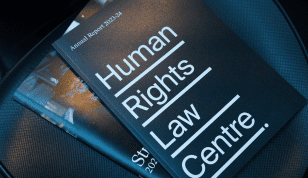Police surveillance of protesters not an invasion of privacy
Caripis v Victoria Police (Health and Privacy) [2012] VCAT 1472 (27 September 2012)
The Victorian Civil and Administrative Tribunal has ruled that a protestor’s right to privacy was not violated by the Victoria Police’s retention of photographs and video footage taken during a protest. The Tribunal accepted that the records were still needed by Victoria Police for legitimate purposes including planning and briefing for further protests and therefore their retention did not violate Victorian privacy laws.
Background
Ms Caripis attended a climate change protest at Hazelwood power station in 2010, organised by the Switch Off Hazelwood Collective (of which Ms Caripis was a member). The Collective had advertised the protest to its members, and informed them that a professional photographer would attend to promote the protest internationally.
Victoria Police filmed and took photographs of the event and retained the images and video footage. Ms Caripis appears in four segments of video footage, with her image visible for less than 20 seconds. The footage and seven still photographs were retained in a locked cupboard. No record existed of the identities of the people in the footage or the photographs, not even their names.
The Claim
Ms Caripis complained to the Privacy Commissioner that the retention of the images and footage was an interference with her right to privacy and that they should be destroyed. The complaint was referred to the VCAT.
Ms Caripis’ complaint relied on the operation of the Information Privacy Act 2000 (Vic) and the section 32 requirement of the Charter of Human Rights and Responsibilities Act 2006 (Vic) (to interpret legislation in a manner consistent with human rights) to claim that: the video and photographs interfered with her right to privacy, were no longer required by the Victorian Police and in accordance with the Information Privacy Act, should be destroyed or de-identified.
The Information Privacy Act provides that:
- an act or practice of an organisation is an interference with the privacy of the individual if it is contrary to the Information Privacy Act’s Information Privacy Principles (section 14);
- any act or practice contrary to an Information Privacy Principle (regarding personal information) is prohibited (section 16);
- an organisation must take reasonable steps to destroy or permanently de-identify personal information if “no longer needed for any purpose” (IPP 4.2); and
- any inconsistent Act or provision prevails over the Information Privacy Act.
Victoria Police claimed that:
- the photographs and video footage did not reveal personal information nor identify Ms Caripis;
- the photographs and video footage was still needed by Victoria Police for intelligence, planning and briefing purposes; and
- the Public Records Act 1973 (Vic) requires retention of the photographs and footages as records “documenting the planned Police response to events such as demonstrations” for seven years.
Decision
Senior Member Steele accepted that the records were still needed by Victoria Police for the purposes stated above, and therefore the retention of the records was consistent with Information Privacy Principle 4.2 and not in breach of the Information Privacy Act.
Senior Member Steele found that the ordinary meaning of “needed” for the purposes of the Information Privacy provision was “useful” or “required” rather than indispensible. Senior Member Steele then went on to consider whether this construction was compatible with the human rights of Ms Caripis, specifically, the right to privacy, the right to free expression and the right to peaceful assembly, with reference to international jurisprudence.
Senior Member Steele concluded that the threat to Ms Caripis’ privacy was not of sufficient seriousness and she could not have had a reasonable expectation of privacy regarding the taking, publication and retention of images and footage for the following reasons:
- the photographs do not focus on Ms Caripis and her face is only identifiable in the video footage in two very brief segments;
- Ms Caripis knew that the protest organisers intended to take and publish images from the event;
- many other protestors took photographs of the protest and uploaded them to social media; and
- Victoria Police had obtained no data about Ms Caripis other than her image, did not know her name and had not engaged in systematic information gathering.
In relation to the rights to freedom of expression and peaceful assembly, while the Tribunal accepted Mr Caripis’ evidence of increased self-consciousness at protests, it was not persuaded that the retention of the material was inconsistent with these rights, given the extent of the recording of the protest by other individuals and the lack of other personal data collected by the Police.
In addition, Senior Member Steele also found that the retention was required for seven years under the Public Records Act and this Act prevailed over Information Privacy Principle 4.2 but, even if it did not, IPP 4.2 did not require the destruction of the footage. The Tribunal did not give any broader consideration to the Charter compatibility of the provisions of the Public Records Act.
Notably, Senior Member Steele found that the Tribunal possessed jurisdiction to consider the question of Charter unlawfulness and that, consistent with her conclusions in relation to section 32, there was no Charter unlawfulness made out on the evidence
Commentary
This case provides an illustration of the types of factors relevant to courts in determining whether an individual’s right to privacy has been violated. In this case, engaging in public acts with the full knowledge that others may be present, the existence of additional or multiple recordings of the public act, and the degree and amount of personal information collected, were all relevant in deciding whether the intrusion was of sufficient seriousness and whether Caripis had a “reasonable expectation of privacy”. It is somewhat curious that the Tribunal did not differentiate between an individual’s expectations in relation the collection of information by the protesters themselves as opposed to the collection of information by the police for a very different purpose. While recognising that the potential “chilling” of police action on protest movements, the Tribunal dismissed Caripis’ arguments on this point with very little discussion.
It is significant that the Tribunal found it had jurisdiction to consider the question of unlawfulness under the Charter. This appears to be the first time VCAT has considered this question following the decision of Director of Housing v Sudi [2011] VSCA 266. Senior Member Steele also conducted an interesting review of the current uncertainty regarding the interplay between section 7(2) and section 32 of the Charter arising from the High Court’s decision in Momcilovic v The Queen [2011] HCA 34 and subsequent consideration by Victorian courts but ultimately considered it unnecessary to form a view on these issues.
While this decision usefully provides consideration of the meaning of the provisions of the Information Privacy Act in light of the Charter, it does not discuss the impact of the Charter on the Public Records Act. The case highlights the tension between the retention requirements of the Public Records Act and the protection of privacy under the Information Privacy Act and the Charter.
The decision is available at: http://www.austlii.edu.au/au/cases/vic/VCAT/2012/1472.html
Richard Griffin is a lawyer on secondment to the HRLC from Lander & Rogers

UK government official whistleblower wins unfair dismissal case against UK government
Ms C Stewart v Foreign, Commonwealth and Development Office: 2204590/2022. A senior UK government official turned whistleblower succeeded in a claim for unfair dismissal against her employer.
Read more
Federal Court rules against injunction to prevent animal cruelty in Victorian abattoir
The Game Meats Company of Australia attempted to stop Farm Transparency International Ltd from publishing a 14-minute video depicting alleged "extreme animal cruelty" obtained by a hidden camera.
Read more
The right to a fair and public trial: considering a private meeting between a judge, complainant, and counsels for the prosecution and defence without the accused present
The High Court on 11 September 2024 overturned a decision made by the Court of Appeal of the Supreme Court of Victoria regarding issues of criminal procedure. The issue of criminal procedure concerned a meeting between the complainant, the judge, and counsel for both the prosecution and the accused (the accused being the respondent to this appeal) on the day before the judge presided over a special hearing to take the evidence of the complainant.
Read more



